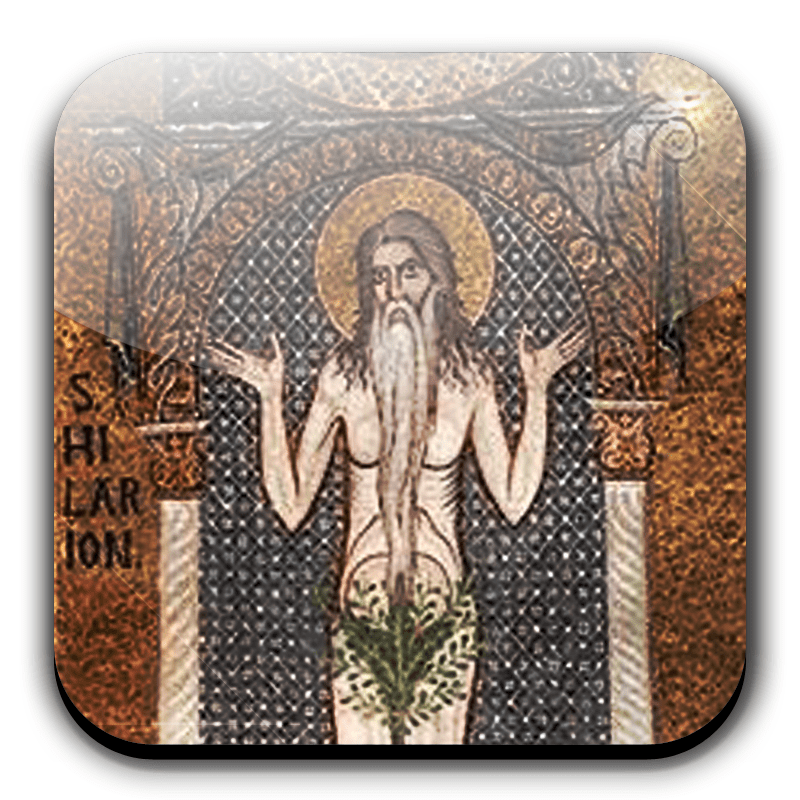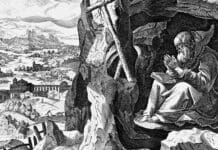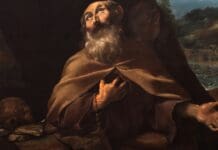St. Hilarion was born in a village called Tabatha, to the south of Gaza, his parents being idolaters. He was sent by them to Alexandria to study, where, being brought to the knowledge of the Christian faith, he was baptized when he was about fifteen. Having heard of St. Anthony, he went into the desert to see him, and stayed with him two months, observing his manner of life.
But Hilarion found the desert only less distracting than the town, and, not being able to bear the concourse of those who resorted to Anthony to be healed of diseases or delivered from devils, and being desirous to begin to serve God in perfect solitude, he returned into his own country. Finding his father and mother both dead, he gave part of his goods to his brethren and the rest to the poor, reserving nothing for himself. He retired into the desert seven miles from Majuma, towards Egypt, between the seashore on one side and a swamp on the other. His clothing consisted only of a sackcloth shirt, a leather tunic which St. Anthony gave him, and an ordinary short cloak. He never changed a tunic until it was worn out and never washed the sackcloth which he had once put on.
For food he ate only fifteen figs a day, which he never took till sunset. His occupation was tilling the earth and making baskets, whereby he provided himself with the necessaries of life. He built himself a cell, that was four feet broad and five in height, and a little longer than his body, like a tomb rather than a house. Soon he found that figs alone were insufficient to support life properly and permitted himself to eat as well vegetables, bread and oil.
While in isolation, he frequently suffered extreme temptations by visions which he identified as demons. He heard voices of infants or of domestic animals, and had visions of naked women, voluptuous meals, chariots and gladiatorial contests
St. Hilarion was informed by revelation in 356 of the death of St. Anthony. He was then about sixty-five years old, and had been long afflicted at the number of people, especially women, who crowded to him; moreover, the charge of his disciples was a great burden. So he resolved to leave Palestine, and the people assembled in great numbers to stop him. He told them he would neither eat nor drink till they let him go; and seeing him pass seven days without taking anything, they left him.
He then chose some monks who were able to walk without eating till after sunset, and with them he travelled into Egypt and at length came to St. Anthony’s mountain, near the Red Sea, where they found two monks who had been his disciples, On the top of the mountain (to which the ascent was very difficult, twisting like a vine) they found two cells to which St. Anthony often retired to avoid visitors and even his own disciples. St Hilarion asked to see the place where he was buried. They led him aside, but they said that St. Anthony had given strict charge that his grave should be concealed, lest a certain rich man in that country should carry the body away and build a church for it.
St Hilarion returned to Aphroditopolis (Atfiah), and thence went into a neighboring desert and gave himself with more earnestness than ever to abstinence and silence. Finding himself too popular also in that place, St. Hilarion spent a year in an oasis of the western desert. But finding that he was too well known ever to lie concealed in Egypt, he determined to seek some remote island and embarked with one companion for Sicily. From Cape Passaro they travelled twenty miles up the country and stopped in an unfrequented place. St. Hesychius, the saint’s disciple, sought him in the East and through Greece when, at Modon in Peloponnesus, he heard from a Jewish pedlar that a prophet had appeared in Sicily who wrought many miracles. He arrived at Passaro and, inquiring for the holy man at the first village, found that everybody knew him: he was not more distinguished by his miracles than by his disinterestedness, for he could never be induced to accept anything from anyone.
He found that St Hilarion wanted to go into some country where not even his language should be understood, and so St. Hesychius took him to Epidaurus in Dalmatia {Modern Croatia). Miracles again defeated the saint’s design of living unknown. St Hilarion, troubled over what he should do or where he should turn, going alone over the world in his imagination, mourned that though his tongue was silent yet his miracles spoke.
At last he fled away in the night in a small vessel to Cyprus. Arrived there, he settled at a place two mites from Paphos. He had not been there long when his identity was discovered, so he went a dozen miles inland to an inaccessible but pleasant place, where he at last found peace and quietness. Here after a few years Hilarion died at the age of eighty; among those who visited him in his last illness was St Epiphanius, Bishop of Salamis, who afterwards wrote about his life to St Jerome. He was buried near Paphos, but St Hesychius secretly removed the body to the saint’s old home at Majuma.

















